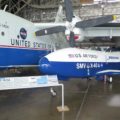
Boeing 307 Stratoliner | |
|---|---|
| Country | USA |
| Role | Airliner |
| First flight | December 31, 1938 |
| Built | 10 |
The Boeing Model 307 Stratoliner was the first commercial transport aircraft to enter service with a pressurized cabin. This feature allowed the aircraft to cruise at an altitude of 20,000 ft (6,000 m), well above many weather disturbances. The pressure differential was 2.5 psi (17 kPa), so at 14,700 ft (4,480 m) the cabin air pressure was equivalent to an altitude of 8,000 ft (2,440 m). The Model 307 had capacity for a crew of six and 33 passengers. In addition to its civilian service it was also flown as the Boeing C-75 Stratoliner by the United States Army Air Forces, who used it as a long-range cargolift aircraft.
| Boeing Model 307 Stratoliner Walk Around | |
|---|---|
| Photographer | Vladimir Yakubov |
| Localisation | National Air & Space Museum |
| Photos | 107 |
Related kits:
| Boeing Model 307 Stratoliner Walk Around | |
|---|---|
| Photographer | Michael Benolkin |
| Localisation | Unknow |
| Photos | 27 |
Find kits on eBay:
See also:
The Boeing 307 Stratoliner was the first commercial airliner to feature a pressurized cabin, allowing it to fly at higher altitudes and avoid bad weather. It was developed from the Boeing B-17 Flying Fortress bomber and entered service in 1938 with Pan American Airways. The 307 had a capacity of 33 passengers and a crew of five, and could fly at a maximum speed of 246 mph (396 km/h).
The 307 was also the first airliner to offer a flight engineer position, who monitored the four Wright R-1820 Cyclone radial engines and the cabin pressure. The 307 was a technological breakthrough in aviation history, but it faced competition from the Douglas DC-3 and DC-4, which were cheaper and more reliable. Only 10 307s were built, and none of them are in service today. The last surviving 307, named the Flying Cloud, is on display at the Smithsonian National Air and Space Museum in Washington, D.C.
Views : 2308











